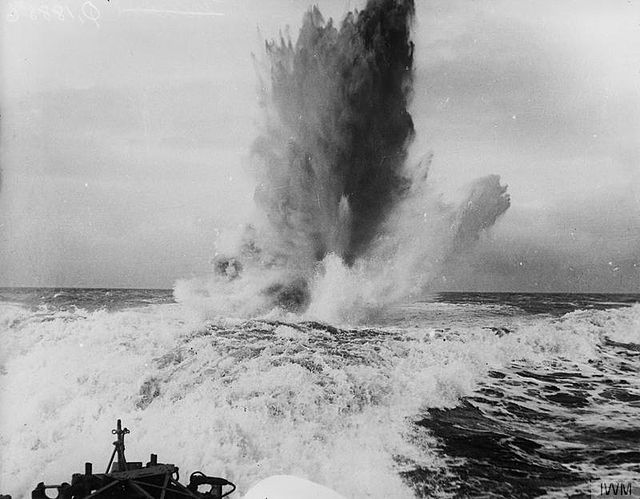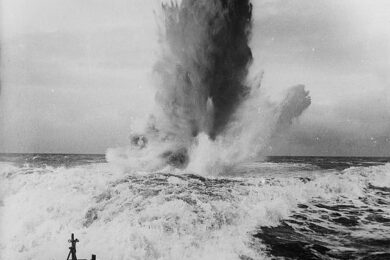From ancient times to the war-torn present, the experience of war has demanded documentation. Homer’s Iliad is a documentary narrative. It comes complete with a catalogue of ships and a roll-call of the dead, many of whom are mentioned only so that their deaths can be recorded. But what are the limits of documenting warfare and how can they be overcome?
The technologies involved remained constant from Herodotus and Thucydides in the ancient world to Edward Gibbon and The Decline and Fall of the Roman Empire in the late eighteenth century. They consisted of words to narrate and describe and images – drawn, painted, or etched – to show. These purposes could and did overlap. Paintings depicted key moments in historical battles; descriptive language evoked scenes of conflict or carnage. Basic to these means of representation is the obvious but neglected fact they are exclusively visual. And so would be the modern innovation that made it possible to record the scene of warfare literally rather than figuratively: photography.
The first wars to be systematically photographed were the Crimean War (1853-56) and, much more exhaustively, the American Civil War (1861-65). Crimean War photographs do not show the wounded and the dead. The most famous of them, ‘The Valley of the Shadow of Death’, shows a broad empty roadway littered with cannon balls: eloquent but mute. The vanishing point at the end of the road seems to lead into the void. Civil War photographs made “the dead on their backs with arms extended wide,” as Walt Whitman described them, visible to the general public for the first time.
Missing from this grim lineage was an advance not made until the 1930s. The sound of war eluded representation, let alone actual recording. But that did not stop people from trying to listen. Photography seemed to inspire a heightened effort to capture the sound as well as the sights of war. War declared itself with a break in the order of sound. It could not be fully documented without some approximation of how it sounded. This form of sonic need is perennial. A formula for it resounds throughout the Iliad: “He fell, and his armour clattered upon him.” Millennia later, W. H. Auden begins a poem on impending war by asking “O what is that sound that so thrills the ear / Down in the valley drumming, drumming?” “Thrills” here means “penetrates” – its archaic meaning. The sound reverberates in the double exclamation of the first line – “O,” “so” – and the double “drumming” of the second. It is terrifying, not because the questioner does not know what it is, but because s/he does.
Gibbon acknowledged the historian’s need for the sound of war when recounting the literal fall of the Roman Empire: the capture of Constantinople by the Ottoman Turks on May 29, 1453. He dismisses the possibility of giving a visually coherent account: “In the uniform and odious pictures of a general assault, all is blood, and horror, and confusion; nor shall I strive, at the distance of three centuries, to delineate a scene … of which the actors themselves were incapable of forming any just or adequate idea.” The alternative was to describe the battle as a cacophony in which shot and shell acted as much by the force of their sound as by the shock of their steel: “From the lines, the galleys, and the bridge, the Ottoman artillery thundered on all sides; and the camp and the city, the Greeks and the Turks, were involved in a cloud of smoke which could only be dispelled by the final deliverance or destruction of the Roman Empire.” Vision becomes blindness under the cloud of smoke. Sound becomes the arbiter of destiny.
When Gibbon published this passage in 1789, music was just beginning to catch up with words and images to supply what they could not: the sound of war. Battle music had been written since the fifteenth century, but apart from Heinrich Biber’s Battle of 1673, which uses string techniques unusual at the time to imitate the sound of field drums and gunfire, battle pieces sought primarily to trace a narrative rather than to recreate a soundscape. Typical was Frantisek Kotzwara’s 1787 The Battle of Prague, which in a version for solo piano remained widely popular through the mid-nineteenth century. Unlike Biber’s, the piece sounds tame and stylized to modern ears. But it formed the model, as Elisabeth Morgan has shown, for more robust piano narratives of battles in the Civil War, produced shortly after the fighting ended. These depictions of battles fought mostly in the South were mostly performed by women in the North. One notable exception is ‘The Battle of Manassas’ by “Blind Tom” Wiggens, an enslaved prodigy and savant. Wiggins performed the piece on concert tours for decades after the war. The music’s cacophony was – is – extreme. Audiences loved it.
Musical mimicry, however, fell far short of actual recording while war photographs remained stubbornly mute. It remained for one writer, someone familiar with Civil War photography and photographers and with wounded and dying men whom he tended in military hospitals, to find a solution, though he used it only once. The writer was Walt Whitman. The solution was to elevate a lowly rhetorical device: onomatopoeia. Normally this means using words or phrases that sound like their referents, which are often sounds: crack, crunch, buzz, shriek; snap! snap! Whitman added the invention of non-words, phonetic sequences that do nothing but imitate sounds directly, and in that way record them.
In early 1865,Whitman published Drum-Taps, a collection mainly of war poems. One of them, ‘The Veteran’s Vision’ (later ‘The Artilleryman’s Vision’) stands out sonically. Its imagery, like that of the volume’s other battle scenes, is photographic in its realism, documentary in feeling, and anti-heroic in attitude. Its narrative, however, is not contemporary with the war. It is projected into the far future to document that its speaker is experiencing flashbacks, suffering a malady – PTSD – for which there was then neither name nor concept. The flashbacks prompt the use of direct onomatopoeia to mimic gunfire, once near the beginning and once near the end:
There in the room, as I wake from sleep, this vision presses upon me:
The engagement opens there and then, in my busy brain unreal;
The skirmishers begin – they crawl cautiously ahead –
I hear the irregular snap! snap!
I hear the sounds of the different missiles – the short t-h-t! T-h-t! of the rifle balls;
I see the shells exploding, leaving small white clouds –
I hear the great shells shrieking as they pass;
The grape, like the hum and whirr of wind through the trees, (quick, tumultuous, now the contest rages! …
Grime, heat, rush – aide-de-camps galloping by, or on a full run;
With the patter of small arms, the warning s-s-t of the rifles…
The poem’s climax consist of its only simile. The phrasing is strongly onomatopoeic: grapeshot, a shower of small iron balls, peals through the line: “The grape, like the hum and whirr of wind through the trees.” But Whitman wants more. He wants to get at the sound itself, not just what the sound was ‘like’. Printed in italics, his invented phonetic sequences measure the intensity of the flashbacks, which so overwhelm the sleeper whom they awaken that he can no longer tell the past from the present.
‘The Veteran’s Vision’ is apparently the first war poem to use direct onomatopoeia. Firsthand accounts of battlefield sounds in the Civil War generally depend on two other techniques. The first is the use of a lexicon of all-purpose similes that Whitman pointedly avoids: rifle fire like buzzing bees or rattling hail, artillery fire like earth-shaking thunderclaps, “thunder as of a thousand anvils” (from John Beatty, The Citizen Soldier, or, Memoirs of a Volunteer) or “the convulsive roar of a thousand unchained thunderbolts.” (from John B. Gordon, Reminiscences of the Civil War). The second technique, which Whitman does use in ‘The Veteran’s Vision’, but with unusual precision, is the accumulation of sonic detail to evoke pandemonium – a term I borrow from Abner Doubleday’s account of the bombardment of Fort Sumter in Charleston Harbor, the attack that started the war: “The roaring and crackling of the flames, the dense masses of whirling smoke, the bursting of the enemy’s shells, and our own which were exploding in the burning rooms, the crashing of the shot, and the sound of masonry falling in every direction, made the fort a pandemonium.”
Joshua Lawrence Chamberlain frames his account of the Union debacle at Fredericksburg five months earlier as an ordeal by sound:
Shot and shell were bursting around us all the way. . . Suddenly two new batteries opened; it seemed as if the ground were bursting under foot, and the very sky was crashing down on us; the bullets hissed like a seething sea. In the midst of the hellish din we heard the bugle call the Third brigade . . . and forward it did go, in line of battle, smooth as a sunset parade, in face of that terrific cross-fire of cannon and rifle, underneath the tempest of shell.
Fifty-some years later, things had changed remarkably little.
Although the phonograph was invented in 1877, audio technology did not develop fast enough to capture the sounds of World War I. What was then the noisiest war in history has come down to us in silence. Wilfred Owen, who heard the war as acutely as he saw it, was no better off than Walt Whitman. He too turned to direct onomatopoeia to preserve some trace of how his war sounded – and to show why its sounds mattered.
Like ‘The Veteran’s Vision’, Owen’s ‘The Last Laugh’ is sui generis:
‘O Jesus Christ! I’m hit,’ he said; and died.
Whether he vainly cursed or prayed indeed,
The Bullets chirped – In vain, vain, vain!
Machine-guns chuckled – Tut-tut! Tut-tut!
And the Big Gun guffawed.Another sighed, – ‘O Mother, – mother, – Dad!’
Then smiled at nothing, childlike, being dead.
And the lofty Shrapnel-cloud
Leisurely gestured, – Fool!
And the splinters spat, and tittered.‘My Love!’ one moaned. Love-languid seemed his mood,
Till slowly lowered, his whole face kissed the mud.
And the Bayonets’ long teeth grinned;
Rabbles of Shells hooted and groaned;
And the Gas hissed.
The soundscape in this text is polyphonic. Quotations from dying men and personified weapons clump together with onomatopoeic words and phrases, most of which refer to inarticulate sounds: guffawing, hissing, groaning; “splinters [that] spat, and tittered.” The collapse of articulation measures the futility of the War. Owen makes that collapse audible with the direct onomatopoeia in the first stanza. Unlike Whitman, he does not bypass words; he negates them. The chirping of the bullets sounds like “– In vain, vain, vain.” Although the meaning of “in vain” would ordinarily apply in this setting, the text instructs us to hear only a high-pitched sound. If we hear a vein of meaning, we hear it in vain. The “tut-tut! of the next line does the same with the British exclamation signifying dismissal or rebuke. We are asked to hear only the savage chuckle of machine guns in a barrage of sharp t’s. The poem, like the War, wrecks havoc on sound.
It would not be long before sound film ‘solved’ the problem of recording warfare. The talkies brought gunfire along with voices. The sounds of fictional war, at least, could be summoned at will. The impossible became the commonplace. But the underlying device is still onomatopoeia. Recorded gunfire is still an imitation, however ‘realistic’, of one sound by another. Real gunfire has a physical impact. It is ‘heard’ by the whole body.
As to World War I, the desire to recover some trace of its sound never quite died out. In 2018, Britain’s Imperial War Museum commemorated the hundredth anniversary of the Armistice that ended hostilities on the Western Front at 11AM on November 11th, 1918, by releasing an audio reconstruction of the moment the guns fell silent. They had raged on until the appointed hour and then just – stopped. During the War, British troops used seismic readings of enemy gunfire, recorded on photographic film, to learn where to direct their fire. The recording at the War Museum used data from a rare bit of surviving film to calculate how the exchange of artillery fire would have sounded by the Moselle River between 10:59 and 11:00.
Visitors listened by placing their elbows on a sound bar and covering their ears with their hands. The artillery sounds were thus felt as well as heard. The bodily aspect of hearing live fire was partially restored by making the body the medium of transmission. The online version necessarily falls short of that. Its sound is remarkable only because of its historical foundation. Perhaps that is remarkable enough. Recapturing this fusillade, even as a kind of true fiction, is sobering. The war already over but the day’s casualty count was almost 11,000, far higher than on D-Day in World War II. Why the relentless shelling? Hearing about it is one thing; hearing it is another.
But that is not all we hear. The recording ends with a moment of sheer fabrication. The sounds of the artillery stop and their reverberations fade into silence (or rather into a background hiss that sounds – deliberately? – like the groove sound of an old phonograph record). But the silence is fleeting. The remaining several seconds are filled with birdsong. Fiction has entered the historical soundscape.
Was the silence too uncomfortable to let stand? Were the singing birds supposed to be harbingers of peace or signs of resilient nature persisting in the face of human folly? Or were they there just to be emotionally true but factually false? What need did their song satisfy?
Sonic need comes in many varieties. The need for the sound of war is only one of them. But to satisfy the need requires not only that we hear something, but that we listen from the auditory equivalent of a point of view. If we hear those big guns of 1918 and nothing else, what we hear is inert, a kind of sonic souvenir. But if we hear those guns from the point of audition supplied by the added birdsong, we hear the Great War end.
Experiencing Sound: The Sensation of Being by Lawrence Kramer is published by University of California Press




